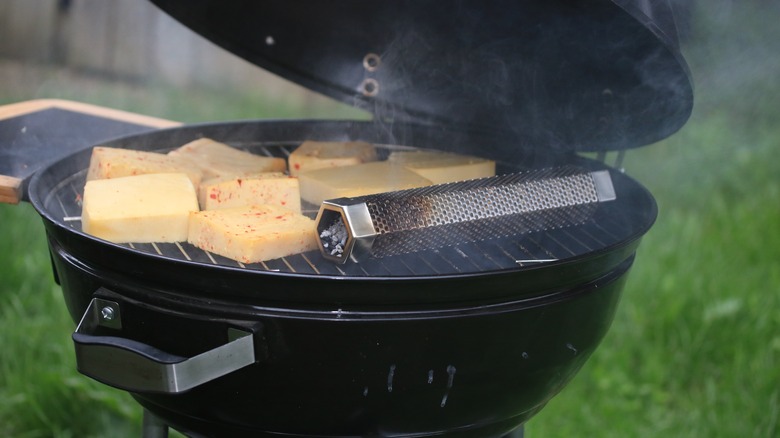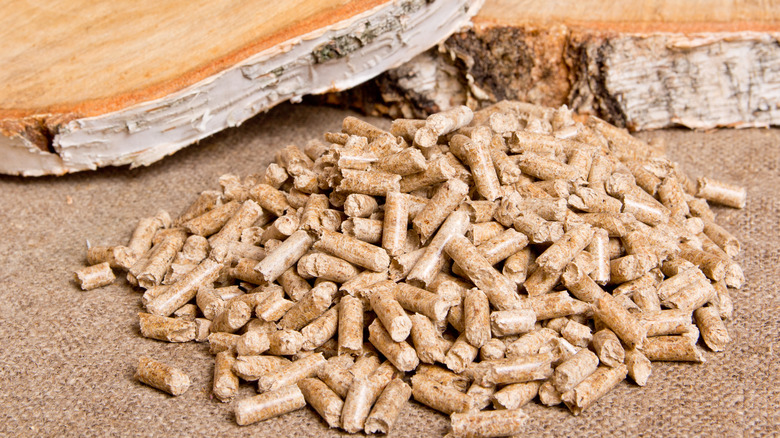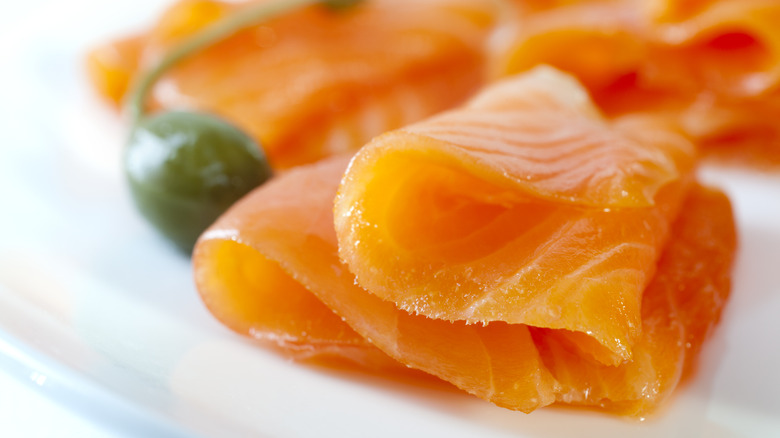Why You Should Start Cold Smoking Food On The Grill
Heavy barrel- or egg-shaped drums, loads of hardwood, and piles of tender meat probably come to mind when you think of food that has been smoked. Known as hot smoking, this method uses both heat and smoke to simultaneously cook and flavor food. However, hot smoking has a gentler, quicker, and (literally) cooler distant cousin that you can pull off right in your backyard grill.
Cold smoking does not actually cook the ingredients, but instead acts more as a smoky seasoning. Because the temperatures stay low — less than 86 degrees Fahrenheit — there is no change to the texture. It is a way to add intrigue, sophistication, and creativity to a variety of proteins, vegetables, and even cheeses. Once you get the hang of it, the process is a straightforward and hands-off way to seriously upgrade your cooking game. When done right, cold smoking can also be used to preserve meats that have first been salt-cured.
Cold smoking guns, generators, or cabinets may be worth the investment for serious hobbyists or small businesses, but they really are not necessary for the average person who just wants to give the technique a try. Any kind of barbecue or grill will do the trick. You will need a wood product — pellets are a good place to start, but some people prefer sawdust or small wood chips. You will also need a maze tray, perforated metal pan, or pellet tube, a large non-perforated heat-safe pan, a wire rack, thermometer, and ice.
How to cold smoke in your backyard grill
First, fill your maze smoker tray, pan, or tube with pellets, sawdust, or wood chips — do not pack them in too tightly, as the wood needs oxygen to stay lit. Place the tray on the grill rack, light it, and let it sit for about 15 minutes with the lid of the grill closed and the vents halfway open for airflow. The wood should smolder and smoke without throwing up a flame.
Meanwhile, fill another large tray with ice cubes, set a wire rack on top, and place whatever you would like to smoke on the rack. Put the whole stack on the grate of your DIY smoker, close the lid, and let your ingredients smoke for 30 minutes to a few hours — the time will vary based on how receptive the ingredients are to the smoke. As the ice melts, swap it out with fresh cubes, and keep an eye on the temperature to ensure it does not rise above 86 degrees Fahrenheit.
It is always better to be conservative with smoking times until you get more of a feel for the process. Otherwise, you risk creating a finished product that tastes unpalatably ashy. Wood is the essential ingredient that determines the flavor, so go for light and fruity woods like apple, cherry, lemon, alder, or peach. Hickory, maple, mesquite, oak, and pecan impart much bolder tastes that may be overwhelming when smoking milder foods.
The best items to cold smoke at home
For cold smoking newbies, start with something you can consume raw. Cold smoke almonds, cashews, or pecans before roasting to make bacon candied apple spiced nuts. Tomatoes and onions can be cold-smoked, and then combined with lime juice and cilantro for a smoky riff on pico de gallo or salsa fresca. Make a smoked broccoli slaw with golden raisins, sunflower seeds, and a creamy poppyseed dressing, or turn smoked and roasted eggplants into a savory dip. Smoked peaches become a show-stopping sundae topping, and tropical fruits blend into a puree perfect for elevated cocktails and vinaigrettes. Up to an hour is usually a good amount of smoking time.
Cheeses should be smoked for two to four hours. Then, vacuum seal or wrap them in plastic before letting them rest in the fridge for a couple of days — this allows the smoky flavor to disperse fully. Smoked cheddar, Gouda, or pepper jack are perfect to finish a burger, bowl of Texas chili, or a charcuterie board, and smoked cream cheese pairs nicely with bacon-onion balsamic jam and buttery crackers.
Meat and fish are also prime candidates for cold smoking, but they absolutely must be salt-brined first to remove moisture. The drying properties and chemicals in smoke preserve these proteins, but improper handling can lead to the growth of harmful pathogens. When cold smoking these items at home, seek out a detailed and reputable recipe that specifically addresses food safety.



